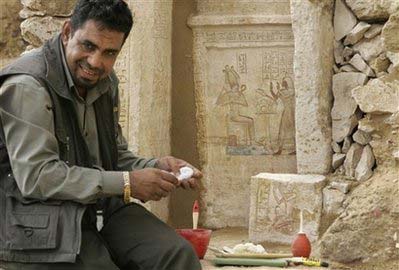Archaeologists have discovered a new pyramid under the sands of Saqqara, an ancient burial site that has yielded a string of unearthed pyramids in recent years but remains largely unexplored.
The 4,300-year-old monument most likely belonged to the queen mother of the founder of Egypt's 6th Dynasty, and was built several hundred years after the famed Great Pyramids of Giza, antiquities chief Zahi Hawass told reporters in announcing the find Tuesday.

|
|
An archaeology worker cleans hieroglyphic details on a white limestone casing at the site of a newly-discovered pyramid at Saqqara near Cairo, Egypt, November 11, 2008. [Agencies]
|
The discovery is part of the sprawling necropolis and burial site of the rulers of ancient Memphis, the capital of Egypt's Old Kingdom, about 12 miles south of Giza.
All that remains of the pyramid is a 16-foot-tall structure that had been buried under 65 feet of sand.
"There was so much sand dumped here that no one had any idea there was something buried underneath," said Hawass.
Hawass' team had been excavating at the location for two years, but only determined two months ago that the structure, with sides about 72 feet long, was the base of a pyramid. The pyramid is the 118th discovered so far in Egypt, and the 12th to be found in Saqqara. Most are in ruins; only about a dozen pyramids remain intact across the country.
Archaeologists also found parts of the pyramid's white limestone casing -- believed to have once covered the entire structure -- which enabled them to calculate that the complete pyramid was once 45 feet high.
"To find a new pyramid is always exciting," said Hawass. "And this one is magical. It belonged to a queen."
Hawass said he believes the pyramid belonged to Queen Sesheshet, who is thought to have played a significant role in establishing the 6th Dynasty and uniting two branches of the feuding royal family. Her son, Teti, ruled for about a dozen years until his likely assassination, in a sign of the turbulent times.